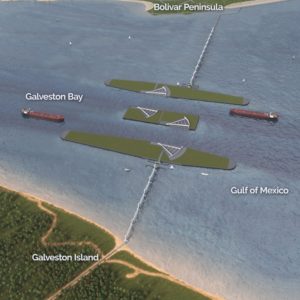Source: U.S. Army Corps of Engineers & Texas General Land Office
By Stas Margaronis, RBTUS
The Texas Legislature will be asked to approve a $26 billion coastal defense network, including $12 billion for storm surge gates to protect Galveston Bay and the Port of Houston from hurricanes and storm surges, according to Tony Williams, environmental review coordinator for the Texas General Land Office.
Williams was addressing the first day of the Storms, Flooding and Sea Level Defense 2020 conference produced by the Propeller Club of Northern California and the Society of American Military Engineers which took place on Zoom on November 18th.
TEXAS
With the approval of the Legislature, Texas will seek funding from Congress for the U.S. Army Corps of Engineers to build the $26 billion project, Williams said.
Speaking in support of the Texas project were:
*William Merrell, professor, Texas A &M University Galveston, who has championed the project for over a decade.
*Meri Davlasheridze, assistant professor, Texas A&M University, Galveston who co-authored a report stating that Texas could sustain $863 billion worth of economic losses from worsening hurricanes and storms over the next 50 years if the coastal defense network is not built.
Williams noted the Texas project could be a role model for protecting coastal communities and ports around the United States.
Niels Aalund, president of the International Propeller Club, said that public opinion in Texas was swinging in favor of the Texas coastal defense project. He said that growing number of hurricanes battering the Gulf Coast is the cause. Aalund is also the senior vice-president for the West Gulf Maritime Association.
Shanghai, Rotterdam and Los Angeles
The conference keynote speaker was Jeroen Aerts, director, Department of Water and Climate Risk at VU University of Amsterdam. Aerts noted that the ports of Shanghai and Rotterdam had addressed storm surge and flooding issues by relocating port terminal facilities into the sea. This provided elevated facilities for better sea level defense and situated terminals so that ocean carriers had faster and more convenient access than sailing inland.
Aerts noted that the Port of Los Angeles Pier 400 project provided a model for the United States to build terminal facilities into the sea using dredge materials.
Port of Los Angeles’ Tony Gioiello, deputy executive director, noted that the Pier 400 project created a seaward barrier that protected inland terminals from wave actions in stormy weather. This helped reduced sea states that disrupt loading and unloading of vessels at inner harbor facilities.
Aerts argued that the seaward movement of port terminals would allow inland and lower-lying flood prone port facilities to be transformed into more elevated commercial and residential housing as was the case for old port facilities in downtown Rotterdam. These properties were transformed into commercial and real estate developments when the 2,471 acre Port of Rotterdam Maasvlakte container and freight handling complex was completed in 2013. This moved inland and downtown vessel-handling terminals out to the North Sea.
Louisiana
Big River Coalition executive director Sean Duffy, U.S. Army Corps of Engineers, Mark Wingate, deputy district engineer, and Port of New Orleans, director of external affairs, Matthew Gresham, all noted the success of a maintenance dredging project that is protecting the shipping channel from the Gulf of Mexico to the Port of New Orleans.
Duffy told conference participants that current projections are that 15,000 acres of land will be reclaimed from the sea by 2023.
National Oceanographic and Atmospheric Administration (NOAA) meteorologist, Dr. Suzanne Van Cooten noted that rainfall levels are rising and creating more frequent threats of flooding such as the catastrophic flooding that paralyzed Mississippi river cities and towns in 2019.
Mississippi River Cities
Mississippi River Cities & Towns Initiative executive director, Colin Wellenkamp said that worsening flooding events along the Mississippi river have caused financial hardships for cities and towns. Localities must rely on limited budgets to recover from increasingly frequent disasters, he said.
Mayor Sharon Weston Broome, representing Baton Rouge, Louisiana, said that the flood of 2016 caused major damage to East Baton Rouge, which included the flooding of the Mayor’s home. Broome said Congress needs to allocate more funding to help riverfront cities face chronic flooding.
Broome and Wellenkamp said that one way to control flooding was to create more watersheds and wetlands to provide for the natural absorption of rainwater and flooding following the example of the Netherlands.
Attendees were welcomed by Danny Wan, executive director, Port of Oakland who said that while the Port of Oakland is in relatively well-protected from storm surges, the Oakland International Airport, which Wan also supervises, will require its runways to be elevated so as to defend against sea level rise.
Arvind Acharya, president, Society of American Military Engineers (SAME), San Francisco, co-sponsored the conference and organized participation from engineering firms around the United States who work on coastal and inland waterway projects. Acharya said that growing threats of sea level rise and climate change require more public attention and collaboration between private contractors and the U.S. Army Corps of Engineers.

